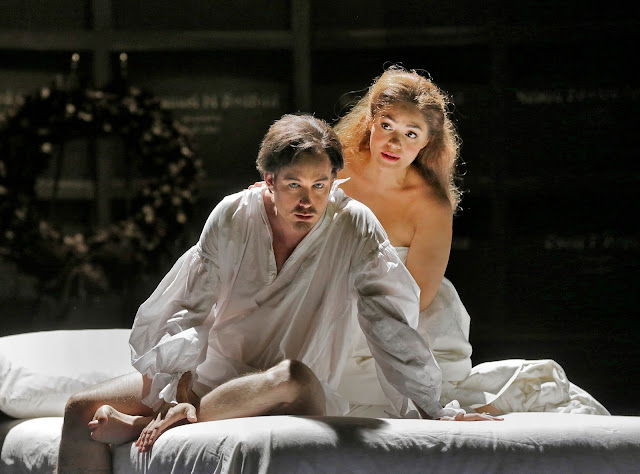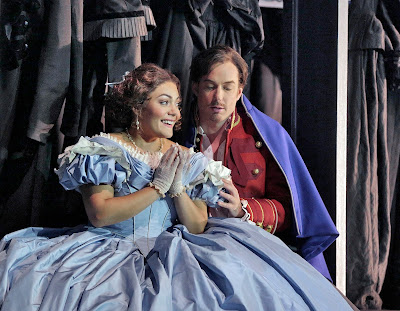 |
| Stephen Costello & Ailyn Pérez in Roméo et Juliette (c) Ken Howard for Santa Fe Opera, 2016 |
 |
| Stephen Costello & Ailyn Pérez in Roméo et Juliette (c) Ken Howard for Santa Fe Opera, 2016 |
Reviewed by Robert Hugill on Aug 4 2016
Star rating:
Santa Fe channels Gone with the Wind in Gounod's elegiac telling of Shakespeare's tragedy
The second opera which we caught at Santa Fe Opera this year was Gounod's Roméo et Juliette, on Thursday 4 August 2016 in a production directed by Stephen Lawless and conducted by Harry Bicket. Stephen Costello was Roméo and Ailyn Perez was Juliette, with Elliot Madore as Mercutio, Emily Fons as Stéphano, Deborah Nansteel as Gertrude, Raymond Aceto as Frère Laurent, Nicholas Davis as Grégorio, Tim Mix as Capulet and Soloman Howard as the Duke. Designs were by Ashley Martin-Davis with lighting by Mimi Jordan Sherin, and choreography by Nicola Bowie.
Gounod's opera, written in 1867, was his biggest hit after Faust. The libretto by Jules Barbier and Michel Carré stays relatively close to Shakespeare, but re-casts the piece as a French grand opera, complete with large-scale choral scenes, grand processions, and a ballet. Gounod wanted to use spoken dialogue but was overruled, and as a result the pacing of the recitative combined with the music for grand ceremonial makes the general pace of the opera quite stately. For all the great beauty of the four duets for Roméo and Juliette, you sometimes wish that Gounod had injected a bit more youthful elan and pace into the piece.
 |
| Deborah Nansteel (Gertrude) in Roméo et Juliette (c) Ken Howard for Santa Fe Opera, 2016 |
The period setting gave the women vast crinolines, which looked attractive though perhaps made the action a little more stately. And it was hard for Ailyn Perez to convey Juliette's youth when she was in a dress which made her look mature, still the evocation of Gone with the Wind was rather effective. Though perhaps less care had been taken with the men's tailoring and their trousers looked as if they had been bought by the yard, even Stephen Costello's were rather unflattering.
The opera started and finished in the same place, the Capulet mausoleum, a huge dark curving wall engraved with names. This formed the fixed set for the whole opera, with openings, staircases and balconies appearing. A central lift in the floor meant that a huge statue of Eros appeared for the balcony scene and also created the bier for Juliette. This was a neat piece of stagecraft as she faints during the wedding with Paris, is laid on the floor and remains in place as the central plinth rises to create a bier for the final scene.
Ailyn Perez has a strongly vibrant lyric voice which at times seemed to suggest spinto hints. Her coloratura, in the waltz song and elsewhere, had a strong, rather spunky quality to it which gave Juliette a robustness to her character. Perez' voice is rather different to the lighter voiced French-style coloratura sopranos who always used to sing this role, and the result was to bring out Juliette's personality, she was anything but shy and retiring, and clearly a bit wayward. This Juliette was a close relation to Maria in Westside Story. I felt that at times, particularly in the more virtuoso passages, Perez pushed her voice harder than was necessary in this space. But Gounod's Juliette is not just about display, he gives the character quite a few quieter, introspective moments and here Perez was profoundly touching, capturing the character's uncertainty and spinning a profoundly beautiful quiet line.
 |
| Beth Miller (dancer), Emily Fons (Stéphano), and Susan Vishmid (dancer), in Roméo et Juliette (c) Ken Howard for Santa Fe Opera, 2016 |
But the main interest is in the interaction between the two principals. Perez and Costello brought out the sculptural beauty of Gounod's writing rather than the white-hot intensity of youthful love. That the two singers were formerly a couple off stage (they divorced in 2015) gave an added frisson to the performance, and the two certainly formed and easy bond. Whilst the balcony scene was poignant and the Act Four dawn scene in Juliette's room was lyrically beautiful, it was the final scene where the performance seem to go to another level. This intense duet really made the occasional longeurs of the work well worth sitting through.
Few of the other characters are as strongly drawn as the principals. Elliot Madore was delightful in Mercutio's Queen Mab speech, virtually the only piece of Mercutio's persiflage that made it from Shakespeare. His final scene was rather more conventional operatic posturing, giving Madore less to work with but overall he impressed and charmed. Deborah Nanteel was delightful as Gertrude, Juliette's nurse, essentially a stock French operatic character but Nanteel was clearly channelling Hattie McDaniel in Gone with the Wind. Similarly Nicholas Davis as Grégorio made much of very little.
 |
| Susan Vishmid (dancer), Tim Mix (Capulet), and Beth Miller (dancer) in Roméo et Juliette (c) Ken Howard for Santa Fe Opera, 2016 |
Cooper Nolan was suitably slimy as Tybalt, with a nice line in goading the opposition, and Thaddeus Ennen looked good in the small role of Paris. Solomon Howard brought great physical authorits to the Duke, and Peter Scott Drackey, Adrian Smith and Jasmine Quinsler provided nice support as Benvolio, Frere Jean and Lady Montague.
Gounod's ballet was kept in, but moved to the Act One ball scene. Though it hardly held up the action, I rather felt that we could have done without this. The hard working chorus, playing both Capulets and Montagues, provided a lively and engaging stage presence supplemented by a large group of actors. Clearly a lot of work had gone into the physicality of the staging, the women moved well in the crinolines (no mean feat) and the men were convincing in their sword fighting (fight directors Rick Sordelet and Christina Kelly-Sordelet).
Harry Bicket and the orchestra brought out the considerable beauties of Gounod's score. His many short orchestral linking passages might hold up the action, but Bicket and his players helped us enjoy the many felicitous details. And the closing pages combined with the singers to create something really special.
Elsewhere on this blog:
- Hollywood noir: Samuel Barber's Vanessa at Santa Fe Opera - Opera review
- Quirky combination: Haydn and Ligeti - Cd review
- Sylvan delights:Gounod's La Colombe at West Green House
- Fascinating sound-world: Bartosz Glowacki on accordion - concert review
- The youthful miller: Robert Murray in Schubert's song cycle - CD review
- Birthday barber: Glyndebourne's production of Rossini's Il barbiere di Sivigla at the BBC Proms - opera review
- More than easy listening: Clara Sanabras' A hum about mine ears - CD review
- Vivid classicism: Danae Dörken, Royal Northern Sinfonia, Lars Vogt in Mozart & Mendelssohn - CD review
- Seriously comic: Rossini's La Cenerentola at Opera Holland Park - opera review
- Sparkle and discipline: Die Fledermaus at Opera Holland Park - Opera review
- Chorus vel organa: Geoffrey Webber and Choir of Gonville & Caius College - CD review
- Remarkable swansong: Tristan & Isolde at Grange Park Opera - Opera review
- Home


%20Ali%20Wright.jpg)
.jpeg)
.jpg)



%20Ali%20Wright.jpg)

No comments:
Post a Comment